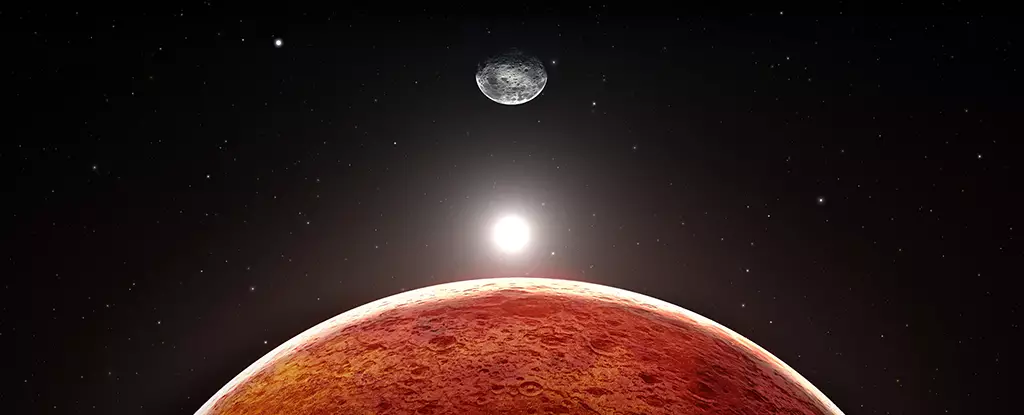Mars, often called the Red Planet, has captivated astronomers and space enthusiasts alike due to its striking and peculiar physical characteristics. Among the most intriguing aspects is its distinct triaxial shape—an irregular form that science has yet to completely explain. Recent propositions by astronomer Michael Efroimsky from the U.S. Naval Observatory have sparked fresh intrigue, positing that a long-lost moon could be the key to understanding Mars’s unusual shape and geological features. This hypothesis not only raises questions about Mars’s history but also helps illustrate the dynamic interplay between celestial bodies in our solar system.
Unlike any other planet in the Solar System, Mars boasts an ellipsoidal form with pronounced differences in curvature along its three primary axes. This distinctive geometric profile has long puzzled scientists who seek to understand the underlying causes of such a shape. Efroimsky’s proposition centers around the idea that a significant third moon—with a size roughly equivalent to a third of Earth’s Moon—once existed in Mars’s orbit, fundamentally shaping the planet’s structure during its formative years.
The concept of a triaxial shape raises more questions than it answers. While planets usually exhibit more spherical forms, Mars’s aminoid-like structure can be viewed as a testament to the cataclysmic forces that have shaped its history. What Efroimsky suggests is that this hypothetical moon, named Nerio—a nod to the Roman war goddess associated with Mars—could have played a crucial role in creating the planet’s enigmatic form.
If Nerio did orbit Mars during its developmental phase, its gravitational pull would have exerted considerable influence on the planet’s morphology. An essential factor leading to the planet’s elongation, this ancient moon supposedly existed when Mars was still a molten and plastic body, presumably exhibiting synchronous rotation. Consequently, Mars would have engaged in a gravitational dance with Nerio, resulting in a shape that leans toward triaxiality.
Efroimsky detailed how the presence of a significant moon could have led to what he terms “seed triaxiality.” This notion implies that the moon’s gravitational forces would have altered the distribution of mass within Mars—effectively elongating it in certain directions. As Mars settled into its current state, the imprint of Nerio’s gravitational dance may have remained etched into its surface for eons.
Beyond the implications for Mars’s shape, the existence of this hypothetical moon could help explain the planet’s myriad geological features, including its towering volcanoes, vast canyons, and highlands. Mars showcases the largest canyon in the Solar System—Valles Marineris—as well as Olympus Mons, one of the tallest volcanoes known. The presence of Nerio could provide insight into why Mars has experienced such pronounced geological phenomena, as the hypothesized moon might have driven more vigorous volcanic activity through tidal forces.
According to Efroimsky, the existence of a substantial moon would have catalyzed convective processes within the planet, setting the stage for tectonic upheavals that could form highland regions and faults. Consequently, the distinctive landmarks we observe today may be remnants of ancient, vigorous geological activity driven by Nerio’s moonlit influence.
Despite the compelling case for Nerio, significant questions remain. For one, there is a lack of direct evidence pointing towards the existence of a moon of such scale that could have impacted Mars. What happened to Nerio? Did it drift into the void, or was it obliterated in some violent cosmic event? As scientists continue to advance their understanding of Mars’s complex geology, there remain multifaceted challenges in piecing together this celestial puzzle.
Future research may probe into ancient impact records, geophysical models, and comparative planetary science to investigate the validity of this lost moon hypothesis. Instruments aboard current Mars missions might contribute data that could unravel whether there are fossilized remnants of such a moon, or at the very least, clarify the dynamic forces that shaped the Red Planet into what it is today.
In essence, Efroimsky’s hypothesis breathes new life into the enigmatic mystery of Mars, suggesting that the secrets of the Red Planet may lay in the gravitational touch of a moon lost to time, providing a narrative about resilience, survival, and the ever-evolving cosmos. As scientists continue their journey to understand Mars and our solar system, we may find that many questions remain—waiting to be explored among the stars.


Leave a Reply